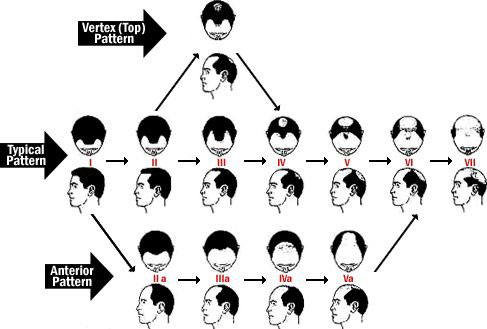The Norwood Classification
A system of hair loss classification is useful in helping doctors compare one patient with another. The Norwood Classification is the one commonly used for male pattern baldness. There are two basic patterns, the most common of which is where hair loss starts in two different areas – the temples and the crown. Less commonly the loss progresses from front to back. Non-genetic hair loss from other causes follows a different pattern:
Type I
No recession
“Adolescent” hairline
Type II
Temporal recession less than 2.5cm
Mild recession along frontal hairline
“Mature” hairline
Type III
Further frontal hairline recession
Deeper recession at corners, “zipper” opening
Primary stage of balding
Type III Vertex
Hairloss predominantly in vertex (crown)
Frontal hairline recession may be present
Type IV
Further frontal hair loss and temporal recession
Enlargement of crown (bald spot)
Solid band of hair across top separating the frontal area from the crown
Type V
Frontal and temporal balding areas enlarge even further
Band separating the two areas becomes narrower and less dense
Type VI
Frontal and crown balding areas merge into one and increase in size
Type VII
Only a narrow horseshoe band of hair remaining
Low hairline in the back
Hair in permanent zone may be sparse
Type A Variant
Frontal hairline recession keeps advancing backwards
Single area of balding
Eventual extent of balding tends to be more limited than in regular Norwood classes
Type IIa
Entire frontal hairline recedes
Type IIIa
Frontal hair loss extends to the mid scalp
Type IVa
Hair loss moves past mid scalp area
Type Va
Hair loss extends towards the crown
Back part of the bald area is narrower
than in the regular Norwood VI










